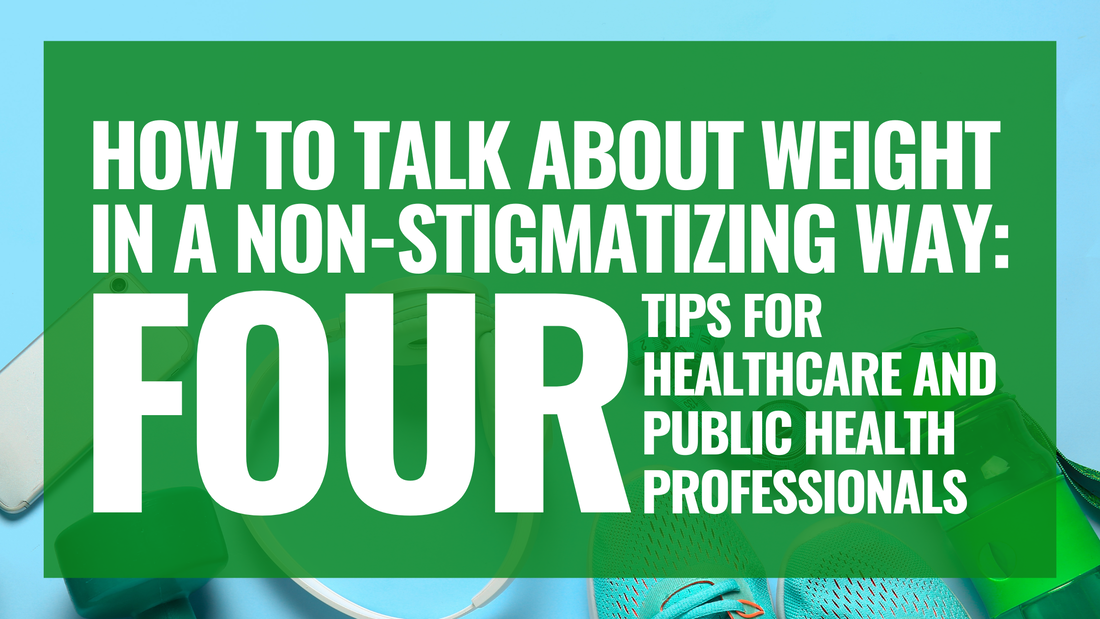|
How we think informs how we speak and can inform how we act. Stigmatizing language about weight can perpetuate weight stigma and weight bias and lead to inadequate care. In order to improve how we talk about weight, we have to first understand how we think about weight.
As we close out Healthy Weight Week, let's reflect on the misconception that weight alone defines health. Looking at someone's weight doesn't reveal their overall well-being. Assumptions based on appearance can be misleading and downright dangerous. You can’t look at someone and think that just because they are a certain size, have a certain body type, or have fat in certain places means that they are or aren’t working out or eating healthy, nutritious foods.
Weight is influenced by various factors, and not all unhealthy behaviors affect weight in obvious ways. For instance, someone with a six-pack may smoke cigarettes, and what may appear as excess weight may hide underlying health issues like fibroids. Weight is a proxy measure. The health indicators that are more indicative of whether our bodies are functioning properly are vital signs like body temperature and blood pressure and markers from blood tests like white blood count, blood glucose, creatine, and LDL cholesterol. While weight is a good metric for understanding our risks for health issues and conditions, let’s remember that there are other measures that truly reflect our physical health and well-being. As public health and healthcare professionals, our goal is to monitor these health indicators and promote the health, well-being, and quality of life of our patients and communities. We can’t promote health if people are avoiding us or are receiving inadequate health care because we’re so focused on weight. Here are some tips for communicating about weight in a non-stigmatizing way: 1. Focus on Holistic Health, Not Weight and Appearance
It’s important to help patients and program participants differentiate between weight and appearance and between weight and health. Emphasizing the importance of adopting a healthy lifestyle for overall well-being, rather than focusing on weight loss, is one way to do so. While weight helps us evaluate risk, it does not provide a clear picture of what is actually happening in the body. Our goal to promote health and well-being should not be centered around shaming or eliminating certain body sizes or types. Our objective shouldn’t be getting someone to a certain number on the scale. We’re better off focusing on promoting healthy behaviors that affect the health indicators that are more indicative of whether our bodies are functioning properly. Because, everyone, regardless of their weight, body type, LDL, blood pressure, etc., needs to be physically active and eat a nutritious, healthy diet with at least 5 servings of fruits and vegetables of various colors a day. Setting care goals around these behaviors is more important and effective than harping on someone’s weight.
2. Use People-First Language and Preferred Terms
Labeling is inherently a mechanism of othering. Ask yourself: Why I am making a distinction based on weight? Is it more important for my patient or program participant to know they are technically overweight or obese, or is it more important for them to understand that they (for instance) need to lower their LDL and blood pressure so their heart isn’t working overtime to pump blood through their body? When talking about someone’s weight, be sure to use people-first language (e.g., "a person with obesity" rather than "an obese person"). Studies suggest that the preferred terms for discussing obesity include "weight" and "BMI," while negative adverbs like "severely" or “morbidly” and negative adjectives such as "fatty," "problem," "unhealthy," and "excess" are discouraged. Stating someone’s weight (e.g., “180 pounds”) is considered neutral, while "obesity" and "fat" are considered least desirable. While these reflect overall preferences, individual preferences can vary. The body acceptance movement emphasizes an empowering and neutral use of the term "fat" with a need for sensitive and individualized communication.
3. Avoid Judgement and Blame
Refrain from using language that implies blame or moral judgment, and oversimplifying the issue or attributing it solely to personal choices. Obesity is a complex issue influenced by various factors, and individuals should not be shamed or blamed for their weight or body size. It’s harmful and ineffective. Ask yourself: Am I making assumptions about my patient or program participant? For example, do you think that someone being classified as overweight or obese means that they are lazy, unmotivated, noncompliant, or lacking in some other way? Are you making judgments about their character and their health habits based on their body type, body size, and/or weight? Are you actively listening to and considering their health concerns, or are you writing off potential health issues as being a result of their body type, body size, and/or weight?
4. Encourage Body Positivity
You can encourage positive body image by highlighting the diversity of body shapes and sizes that exist in the world, that health is not determined by size, and that people of all sizes can pursue and maintain good health. Avoid using language that perpetuates unrealistic beauty standards, contributes to body dissatisfaction, and implies that weight, size, and appearance are central to someone’s healthiness (and attractiveness and value). Focus on progress when it comes to improvement in vital signs and other health indicators, instead of weight.
Check out these additional resources on weight bias, stigma, and discrimination:
0 Comments
Your comment will be posted after it is approved.
Leave a Reply. |
�
Learn about our blog submission guidelines. >>
The views and opinions expressed by individual authors on this blog are their own and do not necessarily reflect the official policy or position of Let's Talk Public Health.
Categories
All
|
|
Highlights
Explore
Connect
|
© 2024 Let's Talk Public Health, LLC. All rights reserved. | View our Privacy policy | Terms of service | Disclaimer | Editorial policy.


 RSS Feed
RSS Feed